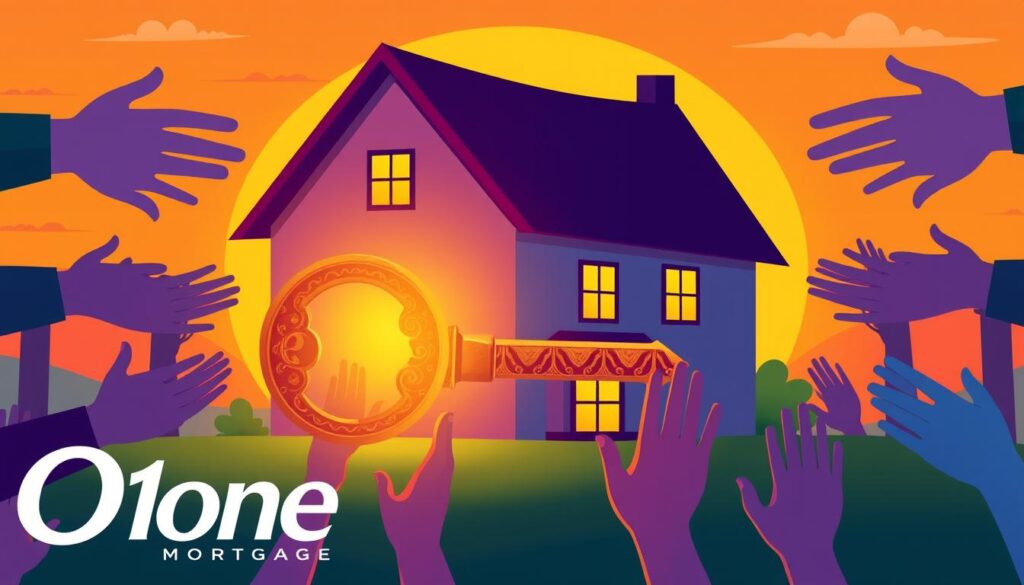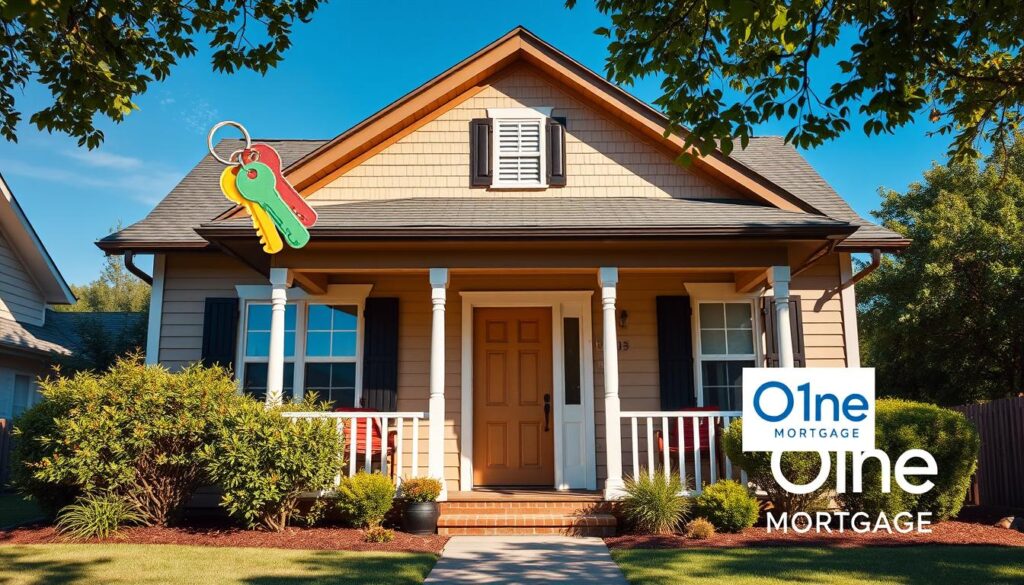As we navigate the challenging landscape of the housing market, down payment grants and home ownership assistance programs emerge as vital tools for many Americans. Our goal is to shed light on the path to affordable housing initiatives and provide dependable guidance on mortgage assistance. For those looking to plant roots, down payment assistance (DPA) programs serve as a beacon of hope, especially for first-time homebuyers grappling with the hefty upfront costs of a down payment.
Eligibility for such programs often requires not having owned a home in the last three years, positioning DPA as a cornerstone for achieving the American Dream. By leveling the playing field, these programs not only unlock the door to homeownership but also contribute to broader economic stability and community development. Let’s explore how down payment assistance can transform the dream of owning a home into a tangible reality.
Key Takeaways
- Down payment assistance bridges the financial gap for first-time homebuyers.
- Programs include loans, grants, and other supports to foster affordable housing.
- Eligibility often extends to those who haven’t owned a home in the past three years.
- DPA programs contribute to economic stability by supporting homeownership.
- Understanding these options is crucial for accessing mortgage assistance.
Understanding Down Payment Assistance
As we delve into the various facets of acquiring a home, down payment assistance programs emerge as a crucial aid for many prospective homeowners. These initiatives offer significant support, ensuring that the dream of homeownership is accessible to a broader group of people. Let’s explore what these programs encompass and their indispensable role in the home buying process.
What Down Payment Assistance Entails
Down payment assistance programs are varied, each tailored to address the different needs of homebuyers. These programs typically encompass grants, forgivable loans at zero percent interest, deferred-payment loans also at zero percent interest, low-interest loans, and matched savings programs. Specifically designed for first-time homebuyers, these homebuyer programs aim to reduce the financial burden that the initial purchase of a home poses, thus fostering greater accessibility to property ownership.
The Role of Down Payment in Home Purchases
The requirement of a down payment in purchasing homes is twofold: it serves as upfront equity in the property and satisfies lender requirements which can range significantly, from a modest percentage to around 20% of the home’s purchase price. Down payment loans and other assistance programs play an essential role by bridging the gap for those who lack adequate savings, thereby making homeownership feasible for a larger population.
Implicit in the design of these down payment assistance programs is their ability to propel individuals into homeownership sooner than they might have managed on their own. By reducing the initial financial hurdle, these initiatives not only aid in acquiring property but also in building financial stability and equity.
Given the critical role that the down payment plays, it’s clear why understanding, accessing, and utilizing down payment assistance programs is pivotal. In our continued efforts to demystify these processes and enhance access to these beneficial programs, we believe that awareness and knowledge are the keys to empowering more individuals in their journey to becoming homeowners.
Eligibility Criteria for First-Time Homebuyers
Understanding the eligibility criteria for first-time homebuyer grants is crucial for those venturing into the realm of homeownership for the first time. Many prospective buyers are unaware that not having owned a home in the past three years categorizes them as first-time buyers, opening a range of possibilities for homeownership assistance.
To fully grasp the opportunities available through homeownership assistance programs, it’s important to familiarize yourself with the foundational eligibility requirements. These generally include parameters related to household income, credit score, and your current homeownership status. Owning rental or investment properties might disqualify you even if you do not live in these properties.
Here, we outline the primary criteria you must meet to qualify for most first-time homebuyer grants and other forms of homeownership assistance:
| Criteria | Description |
|---|---|
| Homeownership Status | No ownership of residential property in the last three years. |
| Income Level | Must not exceed a certain percentage of the Area Median Income (AMI). |
| Credit Score | Minimum credit score requirements vary by program, typically starting around 620. |
| Debt-to-Income Ratio | Must be within acceptable limits, usually 43% or lower. |
| Property Type | Grants must be used for purchasing primary residences only, not for investment or rental purposes. |
| Educational Requirements | Attendance in homebuyer education or financial literacy courses often required. |
Understanding these criteria is the first step towards taking advantage of the benefits that first-time homebuyer grants and homeownership assistance programs offer. While the cycle of qualifying might appear daunting, knowing what is expected can help streamline the process, getting you closer to your goal of homeownership.
How Down Payment Assistance Programs Operate
Down payment assistance programs are designed to support potential homeowners in realizing their dreams of owning a property. By providing essential financial aid, these programs significantly reduce the barriers associated with the upfront costs of purchasing a home. We will explore how these programs can be your gateway to homeownership assistance, particularly through application processes and the types of support they offer.
Application and Approval Process
The journey toward homeownership assistance begins with the application process. Applicants are usually required to submit a comprehensive form, detailing their financial status, property interest, and eligibility for the program. The approval process scrutinizes the detailed information provided to ensure only qualified candidates receive assistance. This method ensures fairness and the effective distribution of resources.
Types of Support Offered by Assistance Programs
Various types of support can make the path to property ownership more accessible and financially sustainable. Key forms of support include:
- Mortgage Assistance: Reducing monthly payments or providing favorable mortgage terms.
- Closing Cost Assistance: Covering essential expenses required to finalize the purchase of your home.
- Grants that do not require repayment, making them an appealing choice for many first-time homebuyers.
Each assistance program may vary in the specifics of the support it offers, including the amount and duration of assistance provided. The cap on assistance, often dictated by the home’s sale price or specific dollar figures, ensures that the support is proportional and targeted.
In conclusion, understanding the operational framework of down payment assistance programs is crucial. These programs not only offer substantial financial relief in mortgage assistance but also aid in covering other significant expenses like closing costs, promoting sustainable homeownership among American families.
Local and Federal Sources of Down Payment Help
When considering the purchase of a new home, it’s essential to explore various sources of down payment assistance. Both local and federal programs can offer substantial aid, and understanding these options can significantly ease the financial burden for homebuyers. Insights into how these programs work, particularly those involving HUD assistance and state housing finance agencies, are crucial for anyone looking to navigate the complexities of buying a home.
HUD assistance, originating at the federal level, provides a plethora of resources meant to make homeownership more accessible. These programs are designed to assist specific demographics, including first-time buyers and those in economically disadvantaged situations. Similarly, state housing finance agencies play a pivotal role. Each state’s agency designs initiatives that cater to its residents’ unique housing needs, often in collaboration with local real estate players.
| Source | Type of Assistance | Target Audience |
|---|---|---|
| Housing and Urban Development (HUD) | Grants, Low-Interest Loans | Low-income, First-time Homebuyers |
| State Housing Finance Agencies | Down Payment Assistance Programs | Residents of the State |
Geographic or demographic focus is a common theme among these assistance programs, with many aimed at revitalizing certain neighborhoods or supporting community development projects. Such strategic focus not only aids individuals but also bolsters overall community wellness through increased homeownership rates.
We encourage potential homebuyers to research HUD and state-specific offerings as a first step towards purchasing a home. The aid provided by these agencies can be transformative, offering not just financial relief but also the support needed to navigate the home buying process smoothly.
Down Payment Assistance and Your Mortgage Options
Exploring various mortgage options can be overwhelming, but integrating down payment assistance can simplify your home buying journey. Whether you’re considering conventional loans or FHA loans, understanding how down payment aid works with these options will help you plan effectively and possibly secure better terms.
Integrating Assistance with Mortgage Planning
When you incorporate mortgage assistance into your financial planning, you enhance your purchasing power and decrease the initial financial burden. FHA loans, known for their lower down payment requirements, can particularly benefit from such assistance programs. These programs not only reduce the amount you need to save upfront but may also affect your mortgage’s interest rate and repayment terms positively.
The Impact of Assistance on Mortgage Terms
Adding down payment assistance into your mortgage arrangement might extend your closing timeline. Coordination between your lender and the assistance program is essential and requires additional administrative effort. However, the long-term benefits including lower monthly payments and potentially reduced interest rates can outweigh these initial inconveniences.
Mortgage assistance programs are designed with flexibility in mind to fit various lender requirements. Below is a comparison of how different assistance impacts FHA loans versus conventional loans:
| Mortgage Type | Typical Down Payment Without Assistance | Down Payment With Assistance | Potential Impact on Interest Rates |
|---|---|---|---|
| FHA Loans | 3.5% | As low as 0% | Possible reduction |
| Conventional Loans | 5-20% | 1-3% | Varies, potential reduction |
We recommend discussing your options with a mortgage advisor who understands how to effectively incorporate mortgage assistance programs into your home buying strategy. This approach ensures you leverage available resources to best meet your financial and homeownership goals.
Grants as a Form of Down Payment Assistance
Within the realm of affordable housing initiatives, down payment grants stand out as a beacon of hope for many prospective homeowners. These grants are unique in that they don’t require repayment, essentially providing free money to assist in purchasing a home. However, it’s essential for recipients to understand the specifics of these grants to fully benefit from them.
We often see that while down payment grants are beneficial, they come with certain conditions. For instance, the grant might place a secondary lien on the property. This means that while the homeowner doesn’t have to repay the grant, the lien must be settled if the property is sold or refinanced. It’s crucial to review these terms carefully and discuss them with a financial advisor or lender before proceeding.
A major advantage of down payment grants for many is their role in facilitating access to housing without the financial burden of a loan. This aspect is critical in ensuring that affordable housing initiatives reach those who need them most, offering a practical solution to the economic barriers that many face in homeownership.
| Grant Type | Typical Amount | Common Conditions | Long-term Benefits |
|---|---|---|---|
| Federal Housing Grants | $10,000 | Must be first-time homebuyer | No repayment required |
| State-Sponsored Grants | Up to 5% of purchase price | Income limits apply | Potentially convertible to a secondary lien |
| Local Housing Grants | $5,000 – $15,000 | Property must be in qualifying areas | Helps retain property value stabilization |
Understanding these aspects of down payment grants not only enables potential homeowners to make informed decisions but also supports the longevity and effectiveness of affordable housing initiatives It remains imperative for all parties involved, from applicants to providers, to maintain clarity about the objectives and parameters of these grants to ensure they make a positive impact on the housing crisis.
It remains imperative for all parties involved, from applicants to providers, to maintain clarity about the objectives and parameters of these grants to ensure they make a positive impact on the housing crisis.
Loan Options Available for Down Payment Support
Exploring various loan options can significantly ease the financial burden of acquiring a new home. We delve into the types of loans that can aid prospective homeowners by reducing upfront costs, allowing more individuals to achieve their dream of homeownership.
Forgivable Loans for Homebuyers
Forgivable loans are a popular choice among down payment assistance options. Occupy the property as your primary residence for a specified period, and you might not have to repay the loan. This type of assistance is particularly beneficial for families looking to settle in new homes without the immediate financial strain of traditional loans.
Deferred-Payment and Low-Interest Loans
Deferred-payment loans are structured to require repayment only when the homeowner sells the property, refinances, or concludes the mortgage term, which can ease immediate financial pressures. Similarly, low-interest down payment loans work alongside your primary or second mortgage, to offer minimal interest rates, facilitating manageable monthly payments.
| Type of Loan | Interest Rate | Repayment Terms | Benefits |
|---|---|---|---|
| Forgivable Loans | 0% | Forgiven after 5-10 years | No repayment if conditions met |
| Deferred-Payment Loans | Low to 0% | Payable at sale, refinancing, or end of mortgage | Immediate financial relief |
| Low-Interest Loans | Below market rates | Concurrent with mortgage term | Reduced monthly payments |
By understanding the different down payment loans available, prospective buyers can better plan their purchases and choose options best suited to their financial situations. Programs like forgivable loans are particularly advantageous, offering a path to homeownership without the daunting upfront costs usually associated with purchasing a home.
Viable Alternatives to Traditional Down Payment Assistance
Exploring innovative pathways to homeownership, it’s vital to consider alternatives beyond traditional grant programs. Options like Individual Development Accounts and lender-specific assistance programs not only broaden opportunities but cater to diverse financial circumstances of potential homeowners.
Matched Savings Programs and Their Benefits
Individual Development Accounts are a compelling option for those looking to save responsibly towards the purchase of a home. By matching the savings you contribute, these accounts amplify your financial capabilities, making the goal of purchasing a property more attainable. The dual benefit of disciplined saving coupled with financial multiplication through matching makes this option especially advantageous.
Lender-Specific Down Payment Programs
Understanding the nuances of lender-specific assistance can significantly impact your homeownership journey. Leading banks such as Bank of America, Chase, and Wells Fargo offer customized down payment programs. These can include grants or matched-saving opportunities, specifically designed to ease the burden of initial home purchasing costs. Opting for a mortgage that aligns with these assistance programs might be required, ensuring that you maximize the benefits provided by your lender.
| Program Type | Features | Examples of Lenders |
|---|---|---|
| Grants | Non-repayable funds | Bank of America, Wells Fargo |
| Matched Savings | Funds matched by lender | Chase, Wells Fargo |
Personalizing Down Payment Assistance to Your Needs
As you embark on the path to homeownership as a first-time homebuyer, understanding how to tailor down payment assistance to fit your unique financial and personal circumstances is crucial. This approach not only makes the journey more manageable but also aligns closely with your long-term mortgage planning goals.
We recognize the diversity in the needs of first-time homebuyers, which is why exploring the right homebuyer programs is essential. Below, we detail various programs and how they can be adapted to suit different buyer profiles.
| Type of Assistance | Benefits | Ideal Candidate |
|---|---|---|
| Grants | No repayment required | Buyers with limited income |
| Forgivable Loans | Becomes a grant if certain conditions are met | Buyers intending to stay in their home long-term |
| Deferred Loans | No payments until home is sold or refinanced | Buyers with promising financial prospects |
| Low-Interest Loans | Reduced interest rates | Buyers who can manage regular payments |
To effectively navigate these options, integrate them with your mortgage planning, considering not only the immediate benefits but also the long-term impact on your financial health. It is advisable to consult with financial advisors or mortgage planners who understand the nuances of these programs.

In conclusion, by carefully selecting the appropriate assistance and aligning it with your mortgage planning, you empower yourself towards a more secure and satisfying home buying experience. Reach out to local housing counselors and use available resources to ensure you make decisions that best suit your needs.
Guidelines for Applying to Down Payment Assistance Programs
Embarking on the journey of homeownership can be both exciting and daunting. As you contemplate applying for down payment assistance, it’s important to understand the steps involved and the documentation required. Each step is designed to guide you towards making informed decisions and securing financial support effectively.
Key Steps in The Application Journey
Begin by researching available down payment assistance programs that you might be eligible for. Useful sources include state housing finance agency websites, city or county government portals, and HUD’s programs by state listings. Once you’ve identified potential programs, it’s critical to connect with the agencies or lenders directly to get detailed program specifics.
After gathering information, the actual application process includes filling out forms and providing necessary documentation. Timely follow-ups on your application status are essential, as this will keep you informed of any advancements or additional requirements.
Documentation and Homebuyer Education Requirements
Documentation plays a critical role in applying for down payment assistance. You’ll typically need to provide proof of income, a credit history report, and personal identification. The importance of compiling these documents cannot be overstated, as they verify your financial status and eligibility for assistance.
Furthermore, many programs require participants to complete a homebuyer education course. Such courses are crucial as they equip future homeowners with essential knowledge on budget management, the importance of credit, and the overall home buying process. Enrolling in a certified homebuyer education program will not only fulfill this requirement but also enhance your understanding of property ownership responsibilities.
By carefully navigating these steps and satisfying documentation and educational requirements, applying for down payment assistance can lead to successful homeownership. Remember, these programs are designed to help you achieve your dreams of owning a home, and taking full advantage of the offered resources will maximize your chances of success.
Conclusion
In reflecting upon the vital role of down payment assistance, we see a beacon of hope for countless individuals striving towards achieving homeownership. Enabling those who might otherwise find themselves forever on the outskirts of becoming homeowners, these programs offer a lifeline to affordable housing. It is through understanding the kaleidoscope of down payment assistance programs that prospective buyers are equipped to navigate the often-intimidating sea of home financing.
We recognize that it is more than just financial support; it’s about nurturing the dream of homeownership and giving it a concrete foundation. The journey to affording your own home can certainly be complex, but with down payment assistance, the path can become less daunting. The cornerstone of this process is getting an early start, arming oneself with knowledge, and closely examining how these programs align with one’s financial landscape.
As we conclude, let us emphasize the power of down payment assistance as a catalyst for not only securing personal abodes but fortifying communities at large. With diligent preparation, staying abreast of developments in affordable housing initiatives, and prudent planning, down payment assistance serves as a crucial stepping stone towards realizing the dream of homeownership and fostering community strength and stability.







